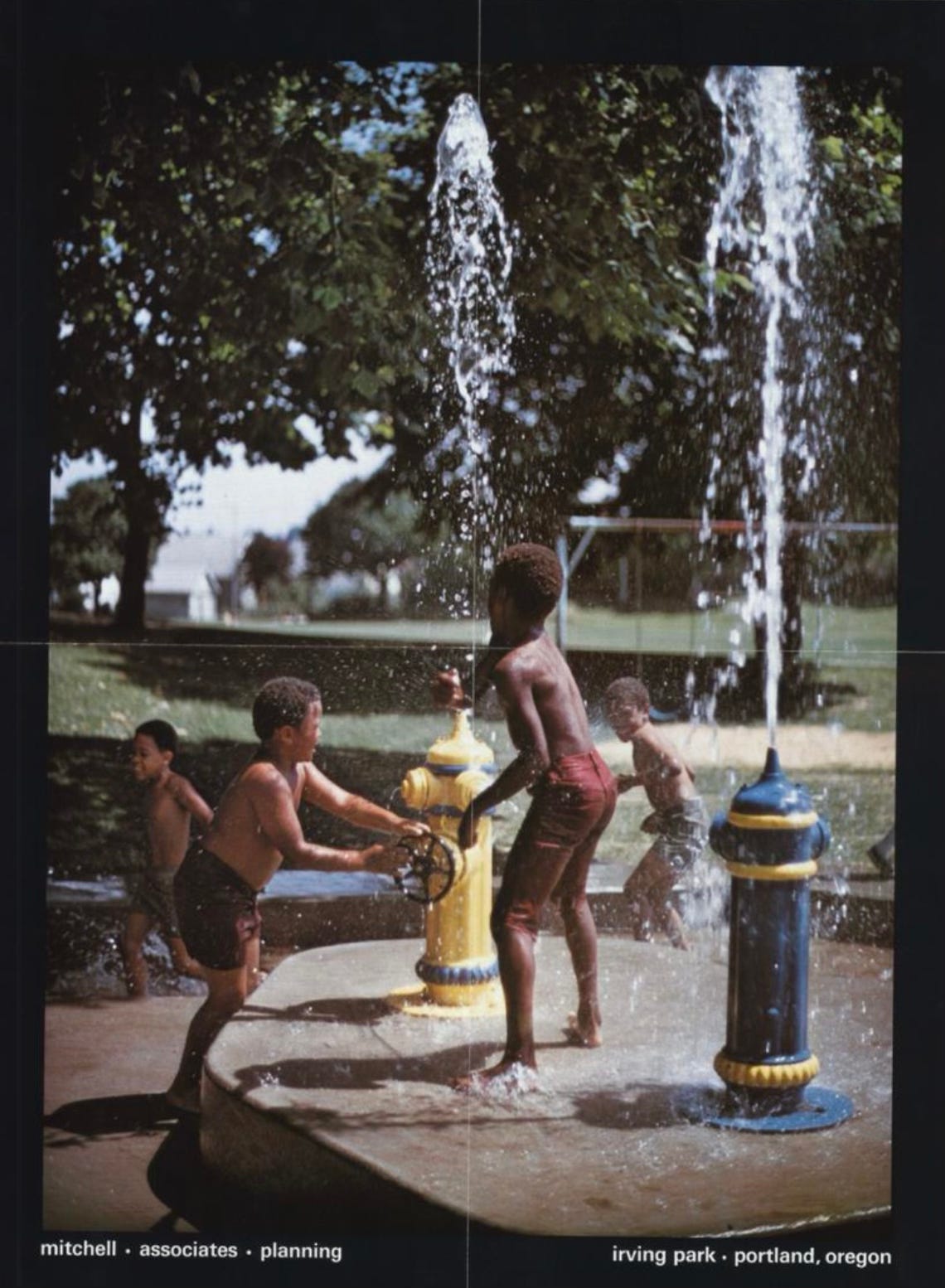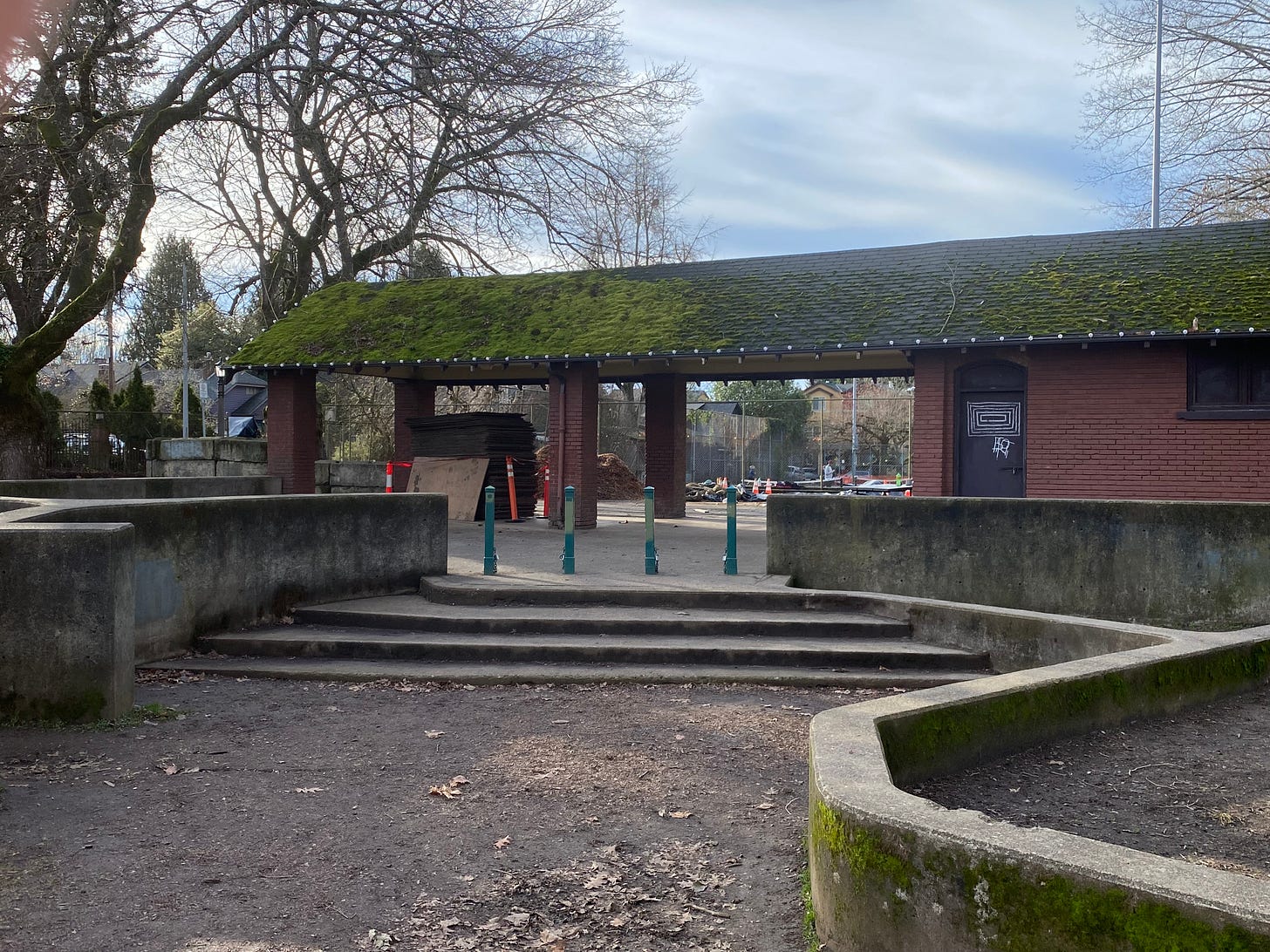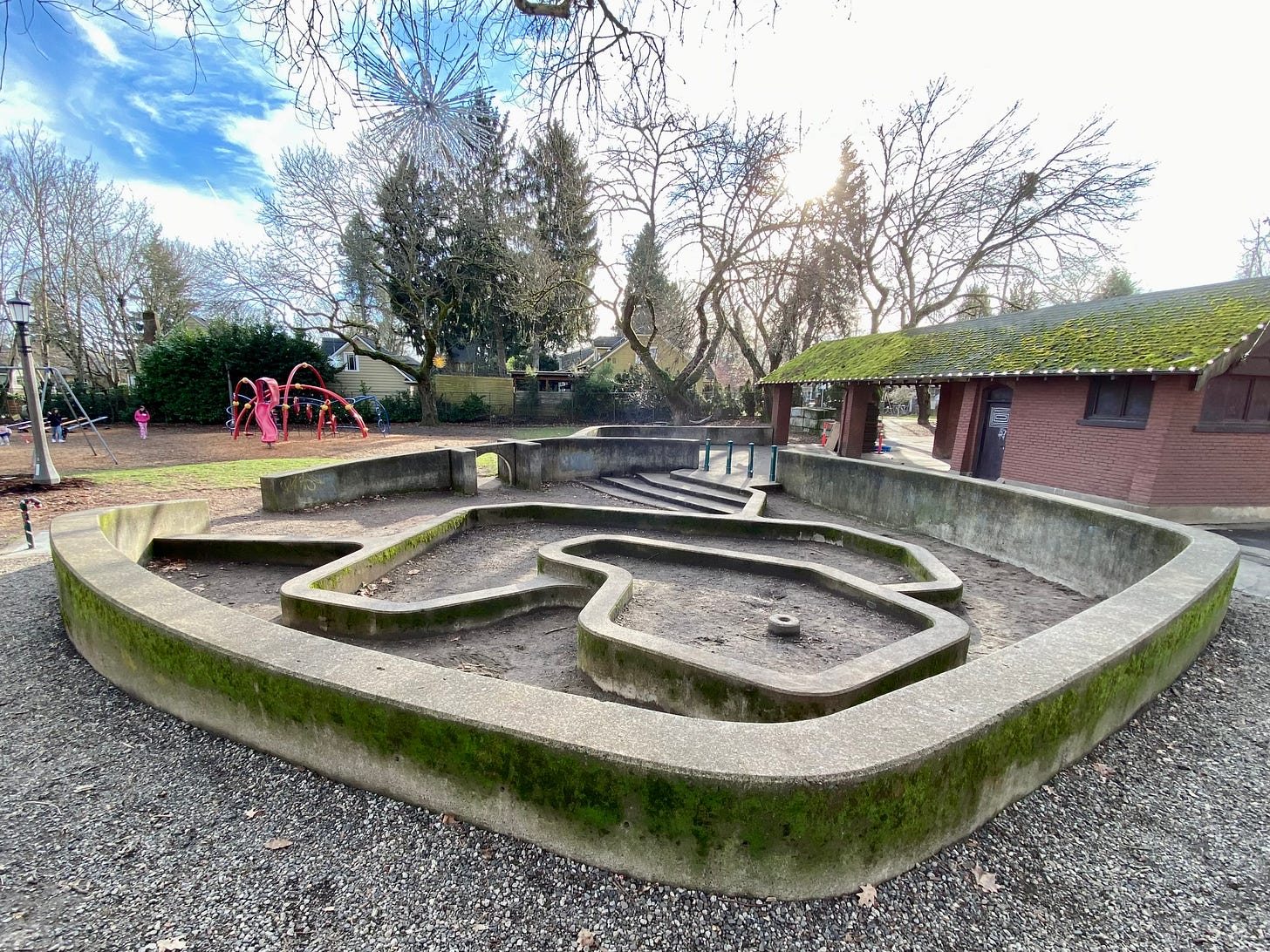Where shall we start this story? Let’s start in the present day. Feel free to let the audio roll and read on.
On December 10th, 2023 I took receipt of a Sennheiser Ambeo Headset. This is a niche product on closeout (once $300, now $50), following Apple’s iPhone changeover to a USB-C port. The headset is of the old wired paradigm, earbud style, but larger and heavier than those that used to come standard with an iPhone, and so requiring a soft coat hanger curl to rest on the top of your ears. The main selling point for me was the promise of exceptional quality binaural sound recording, captured by two tiny microphones facing out from the earbuds.
So I padded over to Irving Park to test it out and no sooner did I arrive at a novel scene when the action was just beginning. The scene itself was familiar: a roughly 75’ wide amoeba shaped concrete derelict terrace and wall in mysterious disuse for several decades. (These days it is mostly enjoyed as parkour grounds.) But on this day, owing to an atmospheric river event, the basin was completely flooded and for the first time in recent history it was briefly brought to life as what I always assumed it originally was: a wading pool.
I was delighted by the hallucinatory sense of space that was captured by the headset: the sparkling splashes bouncing off the concrete, the vivid reconstruction of space the brain can intuit from acoustic cues, particularly when tuning into the range of frequencies the human voice occupies.
Largely indistinguishable from regular earbuds, I was also able to park myself against a low wall, thumbing at my phone while I captured the soundscape of children and adults milling around naturally in the foreground, the ambience of the park and street life in the background.
Later, listening back, I knew I wanted to make music to live alongside it. Something meandering, disinhibited and bemused. And so, last week I did just that. Voila Concrete Jungle, Vernal Pond. I hope you are enjoying it now. (You may get the best listening experience with headphones.)
I found myself curious to know a little more about the concrete relic. Surely it had a story. Surely there are photographs of it in its operational heyday somewhere. So I went to the digital archive of The Oregonian and Oregon Journal to see what I could dig up.
Photographically, I dug up a hole.
In 1972 community organizers in coordination with The Portland Development Commission gathered to commemorate groundbreaking on multiphase renovations to Irving Park, which according to an Oregonian article the previous summer, everybody seemed to agree had been sorely neglected. Here we see the excavation for the concrete features we see today.
Now, I know I’m not the only one intrigued by this. A Reddit post from 2020 asked: So this is in Irving park and it’s clearly not used anymore but does anyone know what it was back in the day? It got 45 replies. The most up-voted reply was:
Ahhh! I actually know this having lived in Boise-Eliot for the entirety of my childhood.
This was not a wading pool. It was a weird cement play structure with raised walkways and giant cylindrical cement tunnel things. It also had raised cement stepping stone type things. ... It’s a bit hard to explain...
Looking back on it the entire area was probably kinda’ dangerous.
It was the 90s.
I had a hard time accepting this. When I moved to the neighborhood in 1997 it looked pretty much identical to today.
Looking closer, you will find in the top terrace a cylinder of concrete with a pipe in the center. That’s where the water came out, I said to myself. The bottom, clearly graded as a bowl, was where it was collected, I said to myself. This well-meaning Reddit user surely just missed the era—the 70’s—where it served as a terraced wading pool, right?
Well, I dug and I dug. The Oregonian archive offered low quality photographs of the Pre 1971 wading pool: a perfect circle now a paved-over area where they corral the massive piles of leaves in the fall. And another, the post mid-seventies wading pool, which still exists in the same rough footprint today, to the east of the ruin. (It was updated with new plumbing and spray fixtures in the 2000’s.)


A fascinating 2023 thesis research paper entitled How Black Portlanders Transformed Irving Park, 1960s- 1980s by Ana Bane also had a clue: an un-dated high quality photo:

Clearly this was not the terraced area with a high wall around it. Though interestingly the wading pool pictured here had a low curb and deck around the perimeter, removed sometime later. The 1987 newspaper photo appears to show the area holding a pool of water, perhaps about ten inches deep.
The citation for the wading pool photograph in the research paper led me to a PDF trove on file at The City of Portland which finally offered up some definitive photographic evidence of the concrete area in its infancy. Sure enough, it was not a terraced wading pool:
Hold the phone! Let’s just briefly analyze these playground structures, in what is referred to as a “tot play area” in schematics. The cylinders are cast concrete culvert segments on end. Some of them taller than an average tot, I’d guess. It doesn’t take much imagination to visualize these becoming trash receptacles does it? And the tire pole? Even if there’s a drainage hole drilled in each tire, they will invariably get plugged from tots filling the tires with dirt, eventually filling up with water and becoming a spawning ground for mosquitoes. The wood beams on end seem like the most engaging thing here, which isn’t saying much. Am I wrong? And why go to all the trouble to make these thick concrete walls and terraces just to scatter some concrete culvert pipes inside? This was a real let-down of a find, actually. This kind of cold, brutalist form-over-function design seems to have be en vogue in the late 60’s and 70’s. Was the designer attempting to make a “tot lot” that was also a minimalist, futuristic sculpture garden…on a budget? Nearby, Unthank Park, built in 1969 was originally the same type of thing, writ large. Perhaps the subject for another post.
The metal pre-fab playground structure in the upper left background of the photo is what I remember from the late 90’s. I remember it being surprisingly tall, with catwalk sections that appeared to levitate, for their lack of buttressing.
Thankfully, another photo revealed some long lost 1970’s structures that looked more promising:
This Barrel o’Fun looks great. A kid-sized hamster wheel? And the Tree Climber thing in the background looks like something a kid would naturally want to engage with. The City Archives PDF trove features a slightly amusing correspondence regarding two Kilgore Corporation Bob-A-Rounds which “failed miserably” in their first year. Under warranty, they were replaced with the Tree Climber 620-000 (presumably what we are seeing in the above photo) and the Flower No. 643-000, which we can only guess at.
Am I wrong to want to think the concrete area was indeed designed and built as a terraced wading pool and re-purposed as a tot lot before it ever spouted water, perhaps because it didn’t meet safety guidelines or the plumbing was botched, or something? Who would know now? If the past half century tells us anything, the concrete will endure as a relic of its mysterious past and keep all visitors guessing.











This was a pleasure to read with your music in my ears and somehow the photos came alive. 💕
Beautiful. <3